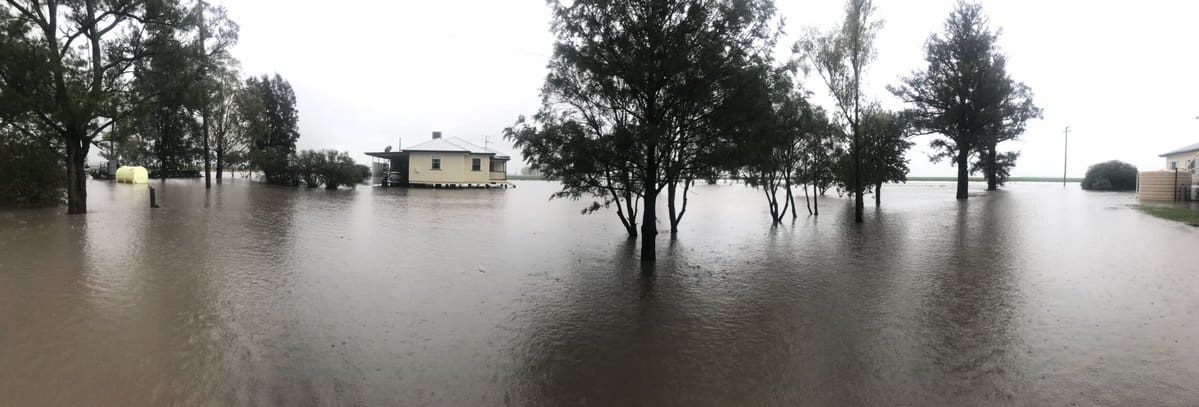
Brookstead on the Darling Downs has received more than 300mm of rain in the past week to consolidate prospects for southern Queensland’s sorghum crop. Photo: Henry Perry
RAIN in the past week across eastern Australia’s cropping areas has halted the winter-crop harvest in late-maturing areas, and prompted some short-covering by end-users to ensure adequate supplies of wheat into January.
Australian Grain Link trader Graham Allen said the reality of the eastern states’ small crop had sunk in, and had also prompted buying for near-term delivery.
“There’s been some excitement this week in ensuring Christmas-New Year is covered, and deliveries will be happening,” Mr Allen said.
Traders said ASW-type wheat had been trading in southern New South Wales at around $445-$450 per tonne delivered end-user.
“We’re trading a market executing from the port, and interior markets are trading within a 250-kilometre radius; our Riverina grain is staying in the Riverina.”
Riordan Grains’ trading manager Mark Lewis said much of the grain outside Victoria’s Western District had been harvested before the heavy rain of recent days.
“Most of the crop was off in the Wimmera and Mallee before it fell.”
Mr Lewis said he thought Victoria had harvested around 80 per cent of its area, and 70pc of its volume, a function of the Western District having the state’s highest yield prospects.
“What is left to be harvested will be affected by weather, and the moisture at 13-14pc is still too high in the samples we’re seeing post rain to make a value about it’s true quality.
“You’d want it down to 11pc before you made an assessment, but everything else that’s been harvested seems to be in the zone in terms of testweight and good quality generally.
“Now we need some good drying weather.”
ASW wheat on-farm in the Wimmera has been trading around $410/t.
“The spot short-term market is quite strong at $430-$440/t Melbourne for ASW wheat.
“There’s a bit of a short-term premium in the market, and the end-user is calling for grain after the rain over the past week or two.”
Growers hold
Barley in the Victorian market has been trading in limited volume at around $390-$400/t, near its normal discount to wheat.
Traders said growers were in no hurry to sell grain, even canola, which was normally sold at harvest to generate short-term cash-flow.
Grower willingness to hold grain has been tied to the general feeling that inland demand will price to import parity calculated off Western Australian wheat landed at NSW and Queensland ports.
That looks likely to remove any downside from price prospects until new-crop 2019 wheat becomes available.
While there is still a long, and probably hot, summer to get through, rainfall totals of 25-100 millimetres, and more than 200mm in places, have buoyed 2019 winter-crop prospects by helping to replenish subsoil moisture.
Sorghum crop big and getting bigger
However the real game-changer this week has been the turnaround in sorghum’s fortunes as a result of the rain last weekend.
Huge localised rains meant the big crop was getting bigger, according to Robinson Grain Toowoomba-based trader Anthony Furse.
“There’s plenty of sorghum planting happening this week and there’ll be growers sitting in planters on Christmas Day because there’s moisture and they’re ready to roll,” Mr Furse said.
The improved prospect for sorghum crops has encouraged sorghum to find its own price level, disengaging from the previously seen $60/t to $80/t discount to wheat.
“Now it looks like wheat prices and sorghum prices will run their own race.
“Wheat will continue to be based off import parity over WA, and sorghum looks like it will pitch itself at levels which engage local demand.”
Wheat delivered Darling Downs March onwards has been $445/t plus carry, while sorghum this week has been testing values between $100/t and $105/t discount to wheat.
Brisbane January wheat, based on trans-shipped WA and SA supply is trading at around $430/t fot, compared with March fot at $425/t.
While the impact of cheaper sorghum would be significant to users in Queensland and northern NSW, traders said wheat would likely remain the input of choice for NSW inland and coastal mills.
The cost of trucking sorghum into southern NSW and Victoria may well see lower-protein WA wheat, trans-shipped via NSW and Victorian ports, become their most affordable grist in coming months.
Cottonseed price directionless
Amid typical late-season tightness of supply, cottonseed continued to remain value for those buying hand-to-mouth cattle feed at around $550/t ex southern Queensland, $500/t ex central NSW and $470/t ex southern NSW sites.
New crop cottonseed is cheaper than current crop, a situation that is normal for this time of year.
However the factors at play are complex. The extreme traded-water tightness in most irrigation valleys partially offsets an otherwise directionless market following the loss of decades of customary business into Narrabri’s now closed crush.
Exports in 2018 were minimal as droughty Australian cottonseed was not as competitive overseas and grazier demand, on top of already strong feedlot usage, stepped up to consume most of the 2018 cottonseed surplus.
Prices for new crop delivery cottonseed, available from southern Queensland to southern NSW May/June 2019 onwards were around $400/t ex northern NSW sites and between $375/t and $380/t ex the central and southern NSW sites.
Grain Central: Get our free daily cropping news straight to your inbox – Click here

HAVE YOUR SAY